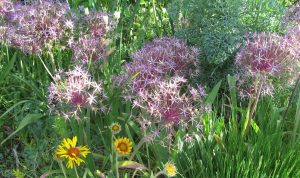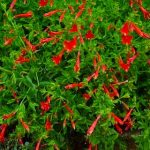
What a storm we had last week! With the windy conditions and record-setting low temps, everyone’s gardens looks very different this week and may need some attention. If you haven’t already, this is a good time to review our blog about garden cleanup. The good news is that soil temperatures have cooled down to the optimal soil temperature for bulb planting, ~50 degrees. And, our current mild daytime temps and above-freezing nighttime temps are ideal for planting perennials, and still good for planting roses, shrubs and trees. Inoculating with mycorrhizae and attention to fall and winter watering are the keys to success.

Bulb Planting and Tulipa ‘Paul Scherer’
Starting with bulb planting: Recommended planting depths are to the bottom of the planting hole where the base of the bulb rests. Planting depth can vary depending on how light or heavy your soil is – plant deeper in light soils, shallower in heavier soils. (If you’re in doubt, a general rule is that planting depth is 3 times the height of the bulb.)
You don’t have to dig a single hole for each bulb! You can dig a large hole, say 8-14″ wide by 16-24″ long, to accommodate a large grouping, or swath of bulbs. This is a great way to save time, to create a more naturalized look, and to combine two or three types of bulbs in one grouping.
Single Early, Triumph, Darwin Hybrid, and Multi-flowering tulips should be planted 8″ deep to perform as perennials, and fertilized each year just after bloom. Be sure to allow the leaves and stems to wither naturally before cutting them down.

You may want to sprinkle bone meal in the bottom of the hole so that it can touch the bulb roots. We love Root Rally, which is a blend of bone meal and Endo/Ecto mycorrhizae spores and plant nutrients, providing mycorrhizae life support for all plants. (See more on mycorrhizae, below.) Refill the hole and water well.
See Eve’s ideas for ways and places to use bulbs that you may not have thought of!
Peruse our complete list of 2019 bulbs and individual images and descriptions

Monarda didyma ‘Jacob Cline’
Planting perennials, roses, shrubs and trees: The fall is a great time to plant perennials, roses and shrubs as they can focus solely on root growth instead of trying to reproduce. After gently removing its pot, gently swish the root ball in a bucket of unchlorinated water with water-soluble mycorrhizae (let the water sit overnight to release chlorine and add the mycorrhizae later). Mycorrhizae is a beneficial fungi that attaches to roots, allowing them to better absorb water and nutrients. This results in faster plant and root growth, and better transplanting success. If you only have granular mycorrhizae on-hand, sprinkle it on the roots as you are planting. Read more about mycorrhizae in Mikl’s article, “Mycorrhizae: The Hidden Marriage of Plants and Fungi”.
By gently swishing the root ball in water, the root mass will loose its pot-shape and individual roots will be lengthened. This allows the ends of the roots to be planted deeper, helping to ensure long-term drought hardiness.
After late-season planting, be sure to (hand) water deeply and frequently, at least twice a month for woody plants, throughout the winter.
For specific info on rose planting, see Eve’s rose planting instructions.

Zauschneria garrettii ‘Orange Carpet’
Finally, a quick additional word on garden clean-up. Some of our Southwestern plants should not yet be cut-back. Wait until April to do so, which will give them additional time to gather and store nutrients, and keep the crowns of the plants from getting too cold. These plants include, but aren’t limited to, Agastache, Salvia (S. lemmonii ‘Desert Rose’, S. reptans, S. x microphyllus ‘Royal Ruby’, S. greggii ‘Furman’s Red’, S. darcyi), Zauschneria (Hummingbird Trumpet), Scrophularia macrantha (Red Birds in a Tree), Scutellaria suffrutescens (Cherry Skullcap), Gaura lindheimeri.
